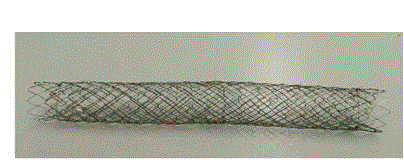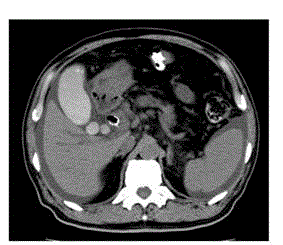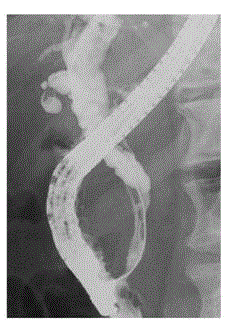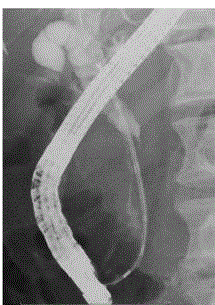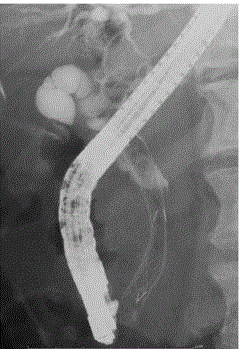Case Report
Treatment for Acute Cholecystitis after Metal Stent Placement in Patient with Malignant Biliary Obstruction using Double Bare Metal Stent
Takeshi Ogura*, Atsushi Okuda, Akira Miyano, Nobu Nishioka, Kazuhide Higuchi
Department of Internal Medicine, Osaka Medical College, Japan
*Corresponding author: Takeshi Ogura, Department of Internal Medicine, Osaka Medical College, Japan
Published: 13 Mar, 2018
Cite this article as: Ogura T, Okuda A, Miyano A,
Nishioka N, Higuchi K. Treatment for
Acute Cholecystitis after Metal Stent
Placement in Patient with Malignant
Biliary Obstruction using Double Bare
Metal Stent. Clin Oncol. 2018; 3: 1435.
Abstract
Endoscopic stent placement using Fully Covered Self-Expandable Metal Stent (FCSEMS) is gold
standard method of treating for malignant biliary obstruction. However, if cystic duct is not
occluded by malignant tumor, when FCSEMS was placed across cystic duct, acute cholecystitis may
occur. In this condition, uncovered self-expandable metal stent (UCSEMS) or plastic stent may
be selected as alternative drainage stent, however, stent patency is shorter than FCMS placement.
Recently, novel UCSEMS is available (Double bare metal stent). This stent may have clinical impact
for long stent patency compared with UCSEMS because preventing tumor in growth may be
obtained, and prevent cholecystitis compared with FCSEMS because cystic duct is not occluded.
Herein, we reported successful treatment for acute cholecystitis after FCSEMS placement using this
double layer metal stent. Double bare metal stent may be effective to prevent acute cholecystitis after
stent placement.
Keywords: ERCP; Double Bare Metal Stent; Metal Stent; Biliary
Introduction
Endoscopic stent placement using Fully Covered Self-Expandable Metal Stent (FCSEMS) is gold standard method of treating for malignant biliary obstruction [1]. However, if cystic duct is not occluded by malignant tumor, when FCSEMS was placed across cystic duct, acute cholecystitis may occur [2,3]. In this condition, Uncovered Self-Expandable Metal Stent (UCSEMS) or plastic stent may be selected as alternative drainage stent, however, stent patency is shorter than FCMS placement. Recently, novel UCSEMS is available (Double bare metal stent, EGIS Biliary Stent; S&G Biotech Inc. Korea) (Figure 1). This stent may have clinical impact for long stent patency compared with UCSEMS because preventing tumor in growth may be obtained, and prevent cholecystitis compared with FCSEMS because cystic duct is not occluded. Herein, we reported successful treatment for acute cholecystitis after FCSEMS placement using this double layer metal stent.
Case Report
A76-year-old man was admitted to our hospital because of obstructive jaundice due to unresectable pancreatic carcinoma. FCSEMS (10mm × 6cm, BONASTENT; Standard Sci-Tech Inc, Seoul, South Korea) placement was attempted. However, after 2 days, abdominal pain and fever up were seen. Computed Tomography (CT) showed acute cholecystitis (Figure 2). Because of cystic duct was not occluded by pancreatic carcinoma according to pre-operative CT, therefore, Stent exchange from FCSEMS to double bare metal stent was attempted. Firstly, duodenoscope (JF 260V, Olympus Optical, Tokyo, Japan) was inserted into the ampulla of Vater. Then, FCSEMS removal was attempted using snare basket catheter, and successfully performed. Next, we inserted Endoscopic Retrograde Cholangiopancreatography (ERCP) (MTW, Endoscopy, Dusseldorf, Germany) cannula and the 0.025 inch guidewire (VisiGlide 1; Olympus Medical Systems, Tokyo, Japan). Next, we injected the contrast medium. According to cholangiography, cystic duct was patency, and biliary obstruction was seen in lower bile duct (Figure 3). We inserted double layer metal stent delivery system (Figure 4), and successfully performed stent placement (Figure 5). This patient underwent chemotherapy, and stent dysfunction was not encountered until he died one year later.
Discussion
Stent placement under ERCP guidance is the gold standard technique to treat malignant biliary
obstruction. For patients having advanced malignant tumor, metal
stent placement may be prefer compared with plastic stent because
stent patency may be longer. Kitano et al [4] conducted comparison
study between FCSEMS and UCSEMS placement for patients
complicated with distal malignant biliary obstruction. According to
this study, stent patency was significantly longer in FCSEMS than in
the UCSEMS (mean±s.d.: 291.3±159.1 vs 166.9±124.9 days; P=0.047).
Therefore, FCSEMS may be more suitable for patients with advanced
malignant tumor. However, FCSEMS has also several disadvantages
such as stent migration or cystic duct obstruction due to metal stent
of covered site. Ho et al [5] reported of complications of Partially
Covered Self-Expandable Metal Stent (PCSEMS). In this study, total
396 patients were included, and stent migration was seen in 9 cases
(2.3%). In addition, acute cholecystitis was also seen in 13 patients
(3.3%). Park et al [6] retrospectively reviewed 98 consecutive patients
who underwent FCSEMS placement and 108 consecutive patients
who underwent UCSEMS placement. According to this study,
although there were not significant differences, acute cholecystitis
was frequently occurred in 5 patients (6.1%) compared with UCSEMS
(1/100, 1%) (P=0.104). In addition, stent migration was seen in only
FCSEMS group (6.1% vs 0%, P=0.011).
To overcome these matters, novel double bare metal stent has
been emerged. This UCSEMS is made of braided nitinol with weaving
into a cross and hook structure. Compared single UCSEMS, this stent
has a unique double-layered structure to improve conformability
and maintain the radial force and flexibility created by crossing two
stents. As result, diameter cell size is small (1-1.5, 2mm at each end)
[7]. This stent may be effective to prevent tumor in growth through
the mesh compared with conventional UCSEMS. Indeed, Lee et
al compared stent patency between double bare metal stent and
UCSEMS [7]. In this study, although rate of adverse events were not
significantly differences, mean stent patency of double bare metal
stent was significantly longer than of UCSEMS (212 days vs 124 days,
P=0.022). Although comparison study between FCSEMS and double
bare metal stent is needed, this stent may have possibility of first-line
stent according to preventing stent migration and obtaining long
stent patency. In addition, double bare metal stent may be effective to
prevent acute cholecystitis after stent placement.
Figure 1
Figure 1
Double bare metal stent (10mm×6cm, EGIS Biliary Stent; S&G
Biotech Inc. Korea); Century Medical Inc., Tokyo, Japan).
Figure 2
Figure 3
Figure 3
Endoscopic retrograde cholangiography showed stenosis of lower
biliary duct and cystic duct was not occluded.
Figure 4
Figure 5
Author Contribution
Takeshi Ogura wrote a paper. Takeshi Ogura, Atsushi Okuda, Akira Miyano, Nobu Nishioka, and Kazuhide Higuchi played roles of interpretation of data for the work, revising it critically for important intellectual content, final approval of the version to be published, agreement to be accountable for all aspects of the work in ensuring that questions related to the accuracy or integrity of any part of the work are appropriately investigated and resolved.
References
- Isayama H, Komatsu Y, Tsujino T, Sasahira N, Hirano K, Toda N, et al. A prospective randomised study of “covered” versus “uncovered” diamond stents for the management of distal malignant biliary obstruction. Gut. 2004;53(5):729-34.
- Isayama H, Kawakubo T, Nakai Y, Tsujino T, Sasahira N, Yamamoto N, et al. Cholecystitis after metallic stent placement in patients with malignant biliary obstruction. Clin Gastroenterol Hepatol. 2006;4(9):1148-53.
- Suk KT, Kim HS, Kim JW, Baik SK, Kwon SO, Kim HG, et al. Risk factor for cholecystitis after metal stent placement in malignant of distal malignant biliary obstruction. Gastrointest Endosc. 2006;64(4):522-9.
- Kitano M, Ho H, Mahajan A, Gosain S, Jain A, Brock A, Rehan ME, et al. Management of complications associated with partially covered biliary metal stents. Dis Dis Sci. 2010;55(2):516-22.
- Park DH, Kim MH, Choi JS, Lee SS, Seo DW, Kim JH, et al. Covered versus uncovered wallstent for malignant extrahepatic biliary obstruction: a cohort comparative analysis. Clin Gastroenterol Hepatol. 2006;4(6):790-6.
- Lee HJ, Chung MJ, Park JY, Park SW, Nam CM, Song SY, et al. A prospective randomized study for efficacy of an uncovered double bare metal stent compared to a single bare metal stent in malignant biliary obstruction. Surg Endosc. 2017;31(8):3159-67.

